Effects of Climate Change on Key or Iconic Food Crops: A Report
VerifiedAdded on 2023/01/13
|12
|3363
|25
Report
AI Summary
This report investigates the multifaceted impacts of climate change on food crop production and food security. It explores how extreme weather events, including intense rainfall, floods, and droughts, disrupt crop yields and distribution. Rising temperatures and altered precipitation patterns are examined for their effects on crop growth, including reduced yields and increased susceptibility to pests and diseases. The report also discusses the influence of increased atmospheric carbon dioxide levels, which, while potentially beneficial, can be offset by other climate-related stressors. The study emphasizes that the most vulnerable populations, those already facing food insecurity, will be disproportionately affected by these changes. The analysis includes the effects of climate change on food systems, including food accessibility, availability, stability, and utilization, and highlights the need for adaptation strategies to ensure a sustainable food supply in the face of a changing climate.
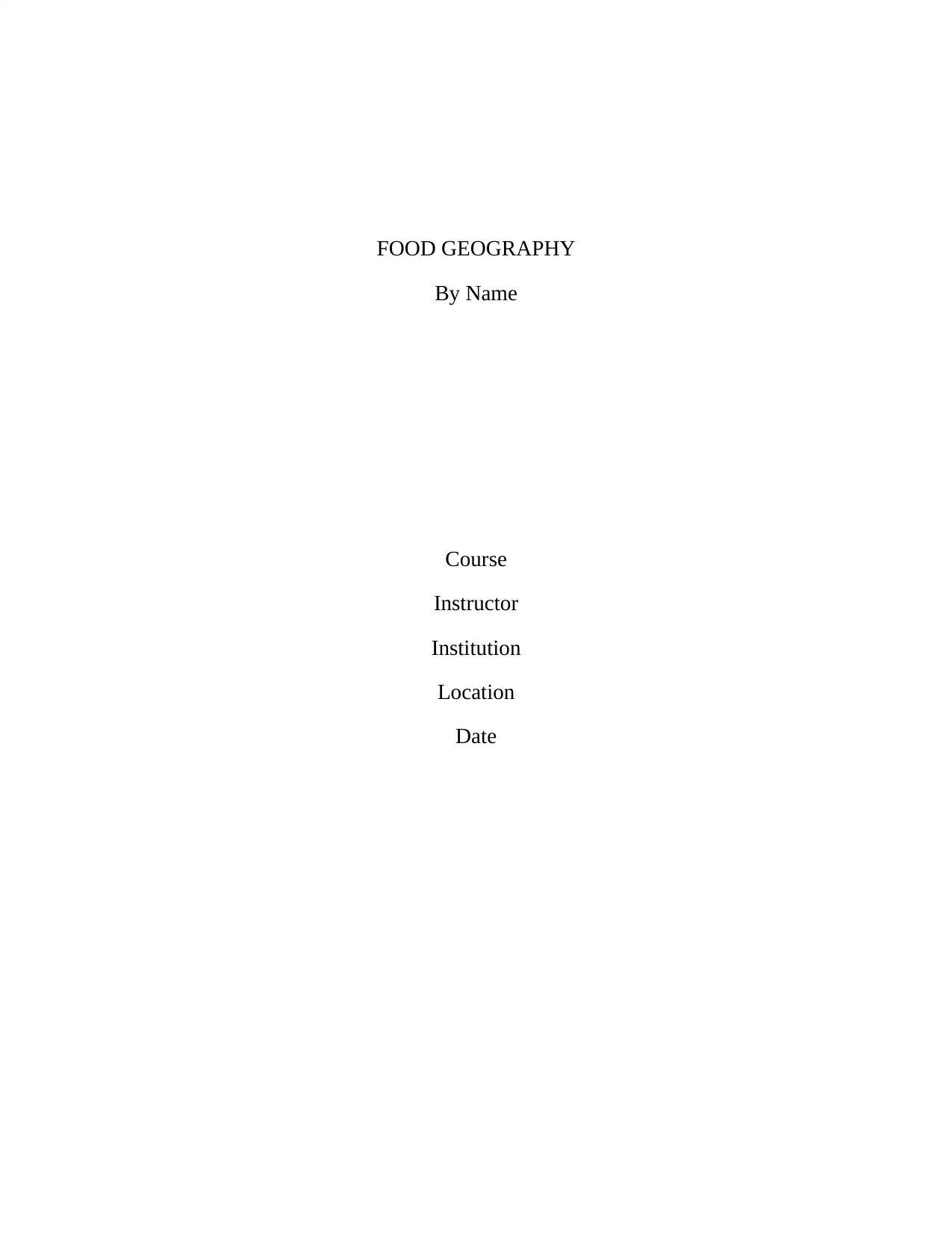
FOOD GEOGRAPHY
By Name
Course
Instructor
Institution
Location
Date
By Name
Course
Instructor
Institution
Location
Date
Paraphrase This Document
Need a fresh take? Get an instant paraphrase of this document with our AI Paraphraser
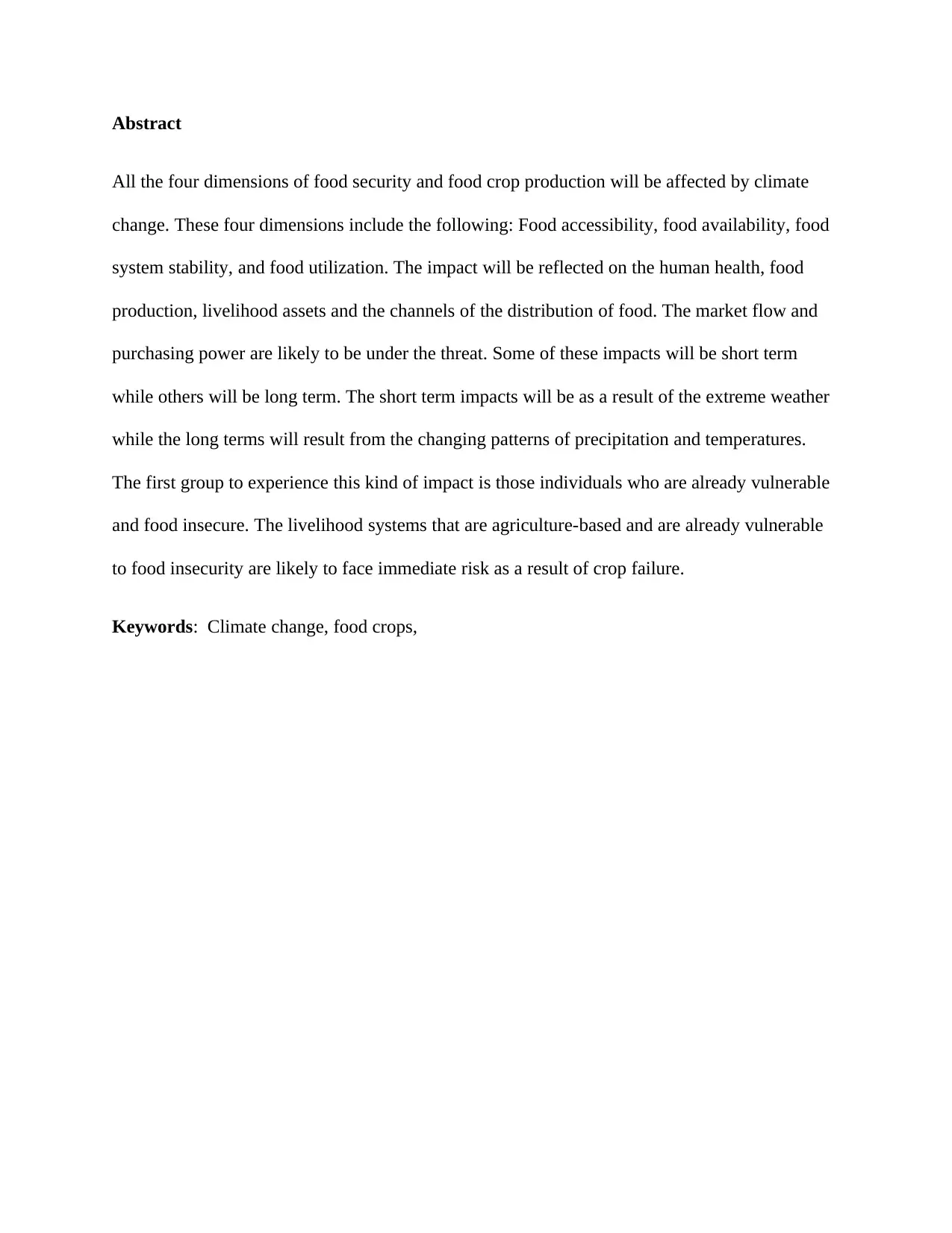
Abstract
All the four dimensions of food security and food crop production will be affected by climate
change. These four dimensions include the following: Food accessibility, food availability, food
system stability, and food utilization. The impact will be reflected on the human health, food
production, livelihood assets and the channels of the distribution of food. The market flow and
purchasing power are likely to be under the threat. Some of these impacts will be short term
while others will be long term. The short term impacts will be as a result of the extreme weather
while the long terms will result from the changing patterns of precipitation and temperatures.
The first group to experience this kind of impact is those individuals who are already vulnerable
and food insecure. The livelihood systems that are agriculture-based and are already vulnerable
to food insecurity are likely to face immediate risk as a result of crop failure.
Keywords: Climate change, food crops,
All the four dimensions of food security and food crop production will be affected by climate
change. These four dimensions include the following: Food accessibility, food availability, food
system stability, and food utilization. The impact will be reflected on the human health, food
production, livelihood assets and the channels of the distribution of food. The market flow and
purchasing power are likely to be under the threat. Some of these impacts will be short term
while others will be long term. The short term impacts will be as a result of the extreme weather
while the long terms will result from the changing patterns of precipitation and temperatures.
The first group to experience this kind of impact is those individuals who are already vulnerable
and food insecure. The livelihood systems that are agriculture-based and are already vulnerable
to food insecurity are likely to face immediate risk as a result of crop failure.
Keywords: Climate change, food crops,
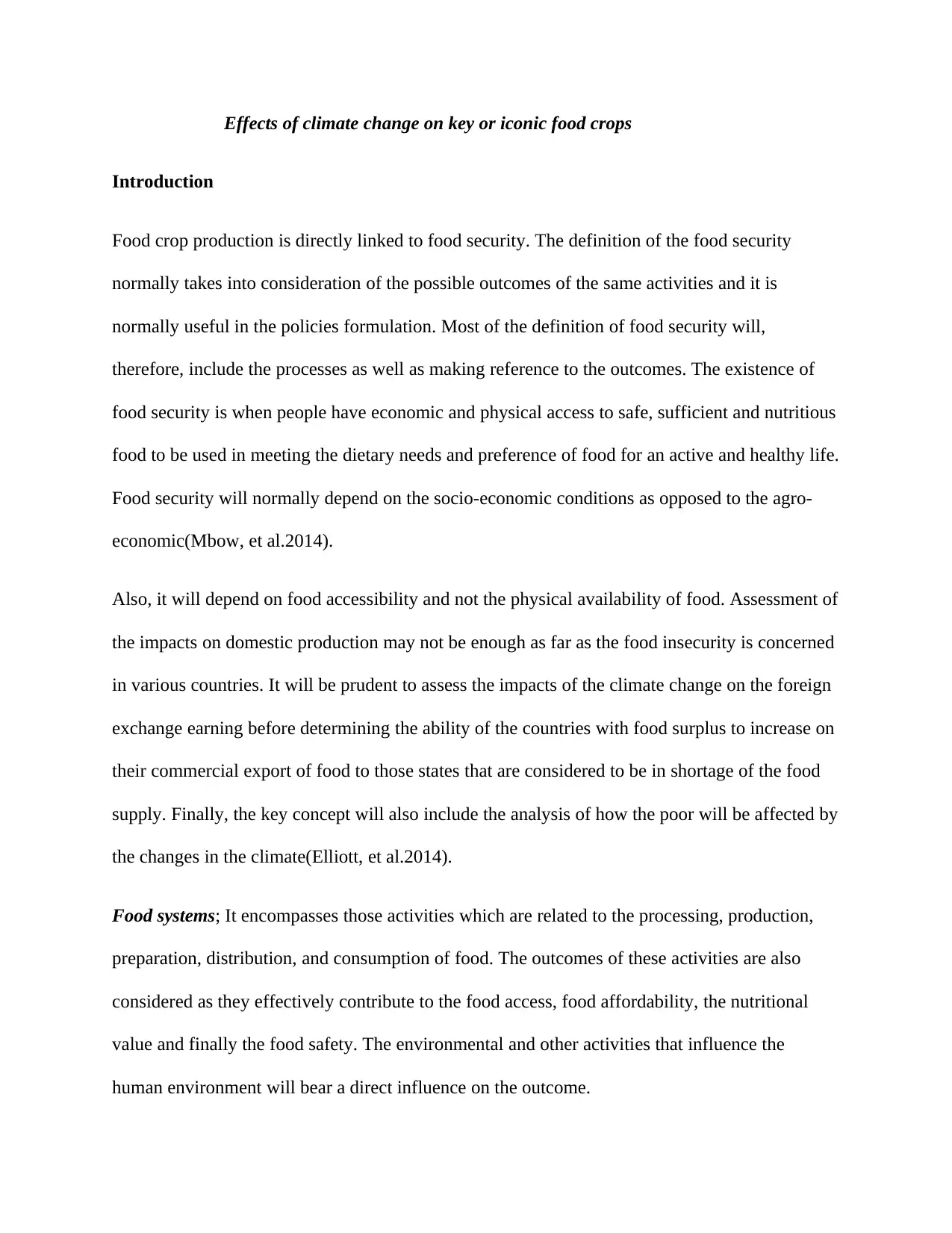
Effects of climate change on key or iconic food crops
Introduction
Food crop production is directly linked to food security. The definition of the food security
normally takes into consideration of the possible outcomes of the same activities and it is
normally useful in the policies formulation. Most of the definition of food security will,
therefore, include the processes as well as making reference to the outcomes. The existence of
food security is when people have economic and physical access to safe, sufficient and nutritious
food to be used in meeting the dietary needs and preference of food for an active and healthy life.
Food security will normally depend on the socio-economic conditions as opposed to the agro-
economic(Mbow, et al.2014).
Also, it will depend on food accessibility and not the physical availability of food. Assessment of
the impacts on domestic production may not be enough as far as the food insecurity is concerned
in various countries. It will be prudent to assess the impacts of the climate change on the foreign
exchange earning before determining the ability of the countries with food surplus to increase on
their commercial export of food to those states that are considered to be in shortage of the food
supply. Finally, the key concept will also include the analysis of how the poor will be affected by
the changes in the climate(Elliott, et al.2014).
Food systems; It encompasses those activities which are related to the processing, production,
preparation, distribution, and consumption of food. The outcomes of these activities are also
considered as they effectively contribute to the food access, food affordability, the nutritional
value and finally the food safety. The environmental and other activities that influence the
human environment will bear a direct influence on the outcome.
Introduction
Food crop production is directly linked to food security. The definition of the food security
normally takes into consideration of the possible outcomes of the same activities and it is
normally useful in the policies formulation. Most of the definition of food security will,
therefore, include the processes as well as making reference to the outcomes. The existence of
food security is when people have economic and physical access to safe, sufficient and nutritious
food to be used in meeting the dietary needs and preference of food for an active and healthy life.
Food security will normally depend on the socio-economic conditions as opposed to the agro-
economic(Mbow, et al.2014).
Also, it will depend on food accessibility and not the physical availability of food. Assessment of
the impacts on domestic production may not be enough as far as the food insecurity is concerned
in various countries. It will be prudent to assess the impacts of the climate change on the foreign
exchange earning before determining the ability of the countries with food surplus to increase on
their commercial export of food to those states that are considered to be in shortage of the food
supply. Finally, the key concept will also include the analysis of how the poor will be affected by
the changes in the climate(Elliott, et al.2014).
Food systems; It encompasses those activities which are related to the processing, production,
preparation, distribution, and consumption of food. The outcomes of these activities are also
considered as they effectively contribute to the food access, food affordability, the nutritional
value and finally the food safety. The environmental and other activities that influence the
human environment will bear a direct influence on the outcome.
⊘ This is a preview!⊘
Do you want full access?
Subscribe today to unlock all pages.

Trusted by 1+ million students worldwide
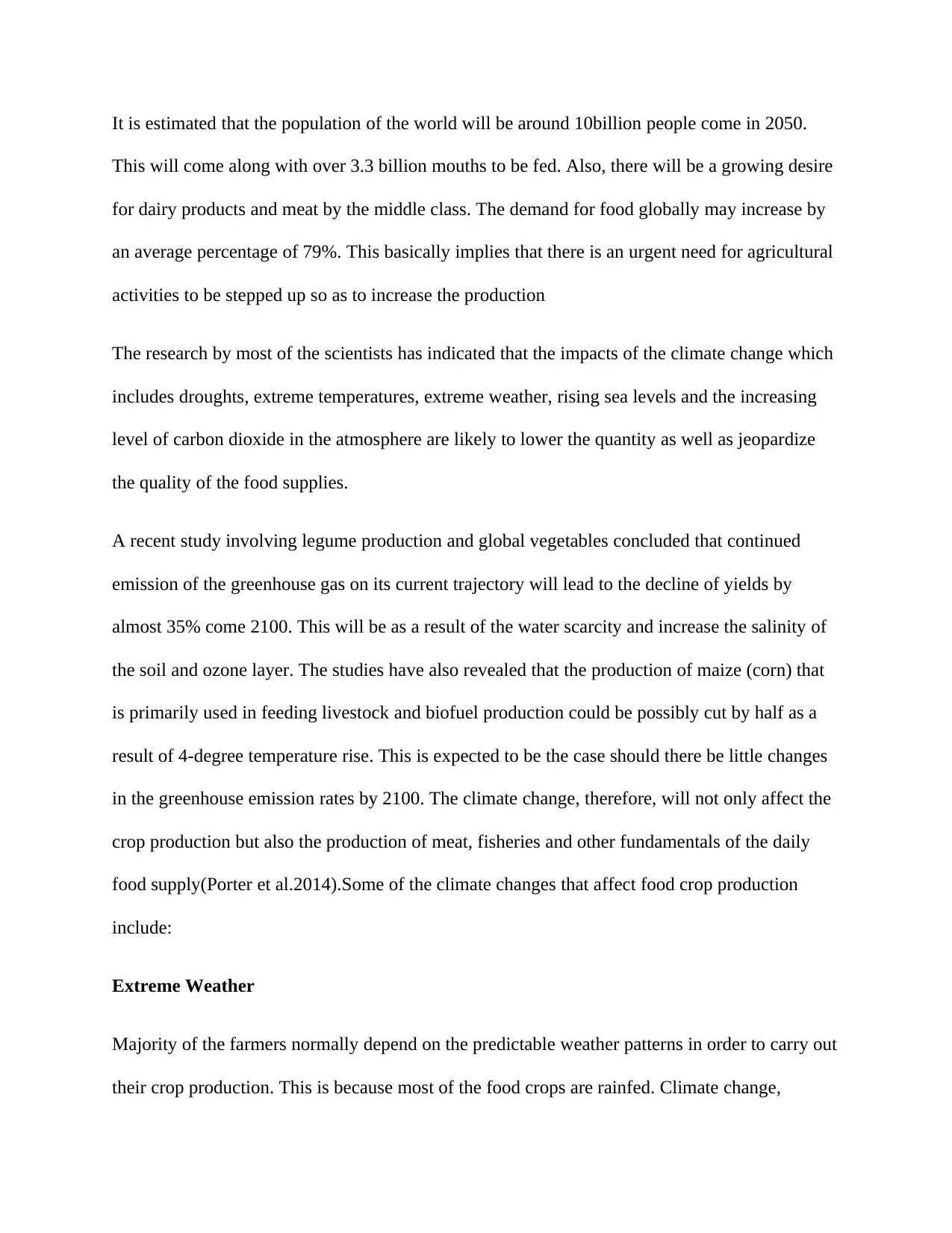
It is estimated that the population of the world will be around 10billion people come in 2050.
This will come along with over 3.3 billion mouths to be fed. Also, there will be a growing desire
for dairy products and meat by the middle class. The demand for food globally may increase by
an average percentage of 79%. This basically implies that there is an urgent need for agricultural
activities to be stepped up so as to increase the production
The research by most of the scientists has indicated that the impacts of the climate change which
includes droughts, extreme temperatures, extreme weather, rising sea levels and the increasing
level of carbon dioxide in the atmosphere are likely to lower the quantity as well as jeopardize
the quality of the food supplies.
A recent study involving legume production and global vegetables concluded that continued
emission of the greenhouse gas on its current trajectory will lead to the decline of yields by
almost 35% come 2100. This will be as a result of the water scarcity and increase the salinity of
the soil and ozone layer. The studies have also revealed that the production of maize (corn) that
is primarily used in feeding livestock and biofuel production could be possibly cut by half as a
result of 4-degree temperature rise. This is expected to be the case should there be little changes
in the greenhouse emission rates by 2100. The climate change, therefore, will not only affect the
crop production but also the production of meat, fisheries and other fundamentals of the daily
food supply(Porter et al.2014).Some of the climate changes that affect food crop production
include:
Extreme Weather
Majority of the farmers normally depend on the predictable weather patterns in order to carry out
their crop production. This is because most of the food crops are rainfed. Climate change,
This will come along with over 3.3 billion mouths to be fed. Also, there will be a growing desire
for dairy products and meat by the middle class. The demand for food globally may increase by
an average percentage of 79%. This basically implies that there is an urgent need for agricultural
activities to be stepped up so as to increase the production
The research by most of the scientists has indicated that the impacts of the climate change which
includes droughts, extreme temperatures, extreme weather, rising sea levels and the increasing
level of carbon dioxide in the atmosphere are likely to lower the quantity as well as jeopardize
the quality of the food supplies.
A recent study involving legume production and global vegetables concluded that continued
emission of the greenhouse gas on its current trajectory will lead to the decline of yields by
almost 35% come 2100. This will be as a result of the water scarcity and increase the salinity of
the soil and ozone layer. The studies have also revealed that the production of maize (corn) that
is primarily used in feeding livestock and biofuel production could be possibly cut by half as a
result of 4-degree temperature rise. This is expected to be the case should there be little changes
in the greenhouse emission rates by 2100. The climate change, therefore, will not only affect the
crop production but also the production of meat, fisheries and other fundamentals of the daily
food supply(Porter et al.2014).Some of the climate changes that affect food crop production
include:
Extreme Weather
Majority of the farmers normally depend on the predictable weather patterns in order to carry out
their crop production. This is because most of the food crops are rainfed. Climate change,
Paraphrase This Document
Need a fresh take? Get an instant paraphrase of this document with our AI Paraphraser
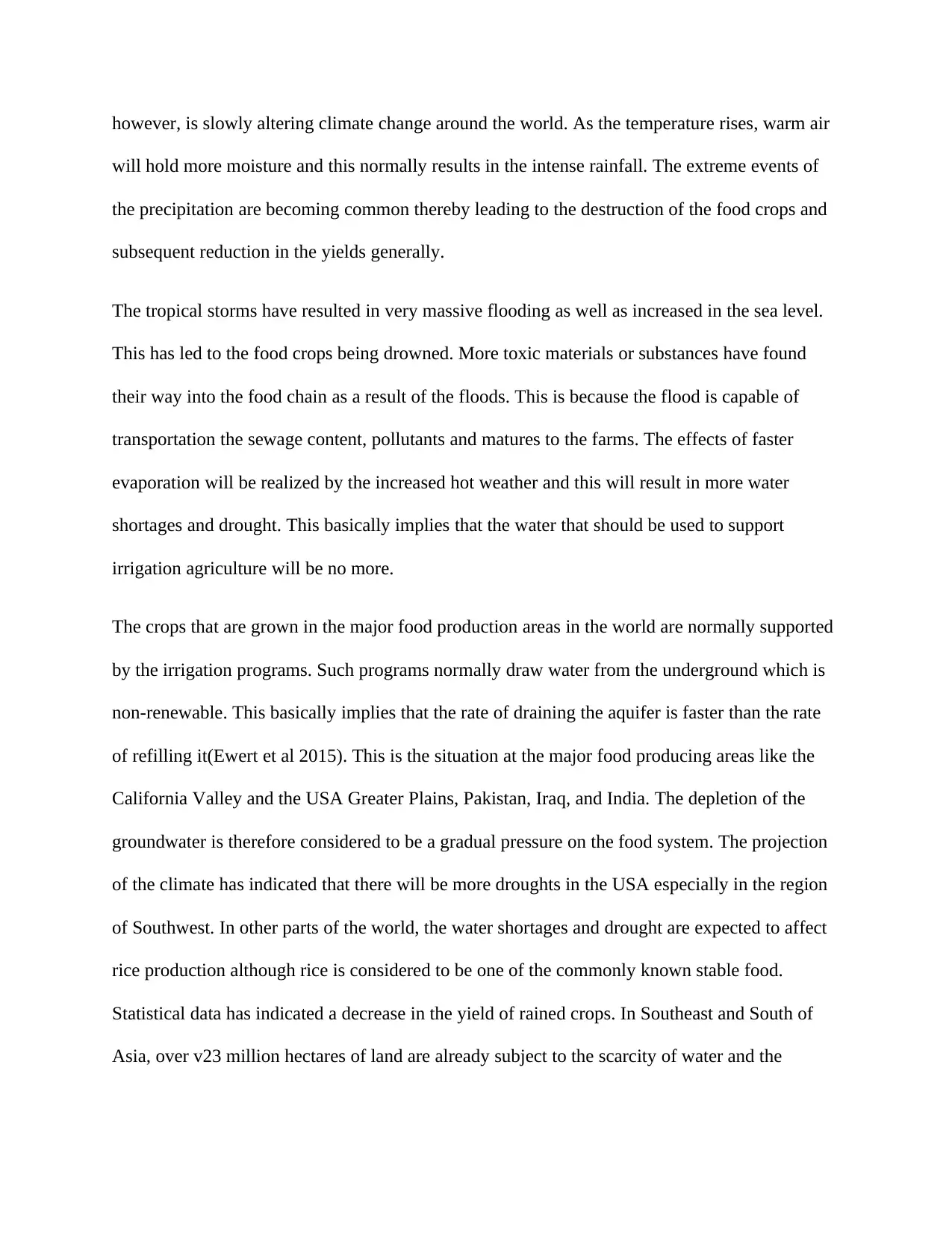
however, is slowly altering climate change around the world. As the temperature rises, warm air
will hold more moisture and this normally results in the intense rainfall. The extreme events of
the precipitation are becoming common thereby leading to the destruction of the food crops and
subsequent reduction in the yields generally.
The tropical storms have resulted in very massive flooding as well as increased in the sea level.
This has led to the food crops being drowned. More toxic materials or substances have found
their way into the food chain as a result of the floods. This is because the flood is capable of
transportation the sewage content, pollutants and matures to the farms. The effects of faster
evaporation will be realized by the increased hot weather and this will result in more water
shortages and drought. This basically implies that the water that should be used to support
irrigation agriculture will be no more.
The crops that are grown in the major food production areas in the world are normally supported
by the irrigation programs. Such programs normally draw water from the underground which is
non-renewable. This basically implies that the rate of draining the aquifer is faster than the rate
of refilling it(Ewert et al 2015). This is the situation at the major food producing areas like the
California Valley and the USA Greater Plains, Pakistan, Iraq, and India. The depletion of the
groundwater is therefore considered to be a gradual pressure on the food system. The projection
of the climate has indicated that there will be more droughts in the USA especially in the region
of Southwest. In other parts of the world, the water shortages and drought are expected to affect
rice production although rice is considered to be one of the commonly known stable food.
Statistical data has indicated a decrease in the yield of rained crops. In Southeast and South of
Asia, over v23 million hectares of land are already subject to the scarcity of water and the
will hold more moisture and this normally results in the intense rainfall. The extreme events of
the precipitation are becoming common thereby leading to the destruction of the food crops and
subsequent reduction in the yields generally.
The tropical storms have resulted in very massive flooding as well as increased in the sea level.
This has led to the food crops being drowned. More toxic materials or substances have found
their way into the food chain as a result of the floods. This is because the flood is capable of
transportation the sewage content, pollutants and matures to the farms. The effects of faster
evaporation will be realized by the increased hot weather and this will result in more water
shortages and drought. This basically implies that the water that should be used to support
irrigation agriculture will be no more.
The crops that are grown in the major food production areas in the world are normally supported
by the irrigation programs. Such programs normally draw water from the underground which is
non-renewable. This basically implies that the rate of draining the aquifer is faster than the rate
of refilling it(Ewert et al 2015). This is the situation at the major food producing areas like the
California Valley and the USA Greater Plains, Pakistan, Iraq, and India. The depletion of the
groundwater is therefore considered to be a gradual pressure on the food system. The projection
of the climate has indicated that there will be more droughts in the USA especially in the region
of Southwest. In other parts of the world, the water shortages and drought are expected to affect
rice production although rice is considered to be one of the commonly known stable food.
Statistical data has indicated a decrease in the yield of rained crops. In Southeast and South of
Asia, over v23 million hectares of land are already subject to the scarcity of water and the
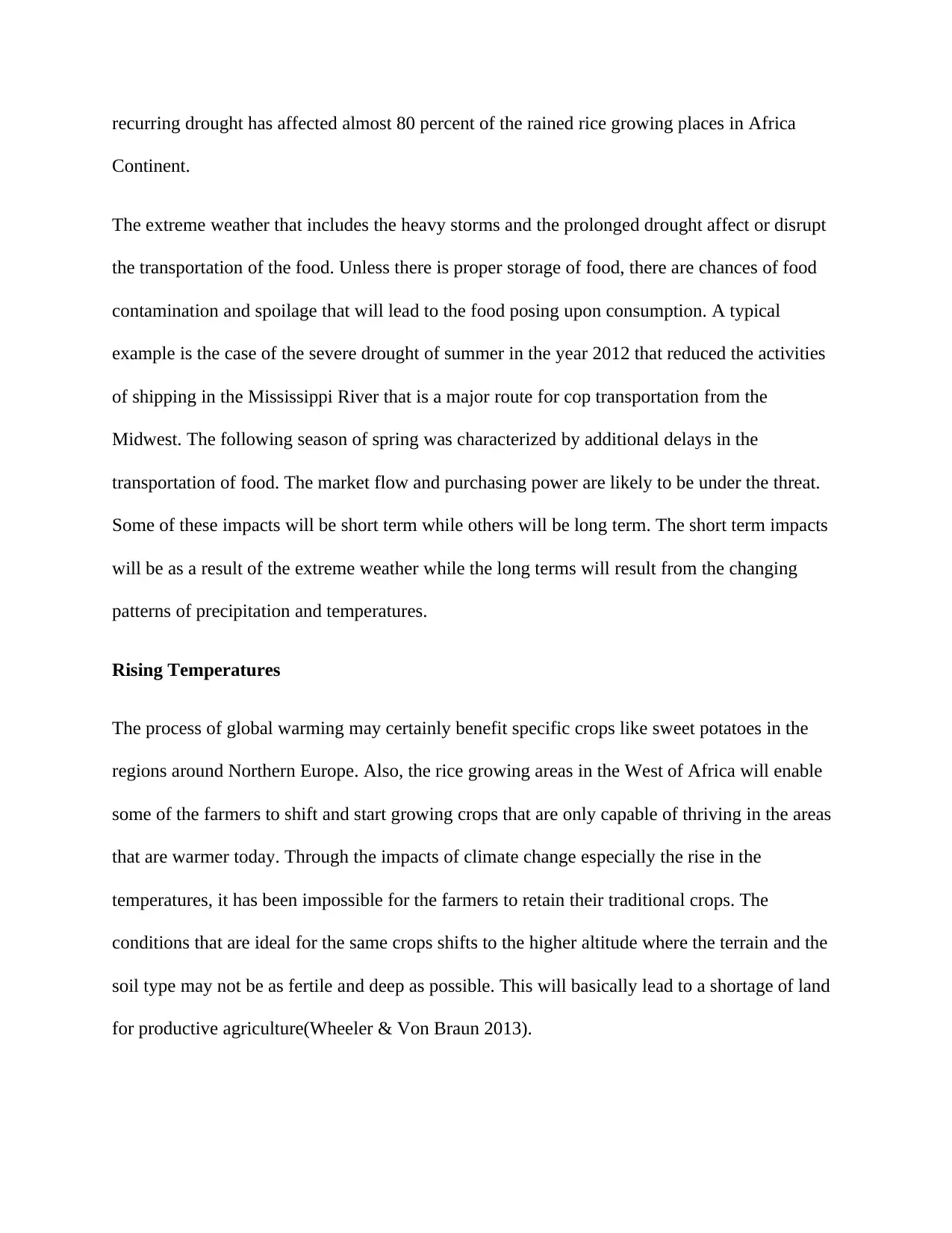
recurring drought has affected almost 80 percent of the rained rice growing places in Africa
Continent.
The extreme weather that includes the heavy storms and the prolonged drought affect or disrupt
the transportation of the food. Unless there is proper storage of food, there are chances of food
contamination and spoilage that will lead to the food posing upon consumption. A typical
example is the case of the severe drought of summer in the year 2012 that reduced the activities
of shipping in the Mississippi River that is a major route for cop transportation from the
Midwest. The following season of spring was characterized by additional delays in the
transportation of food. The market flow and purchasing power are likely to be under the threat.
Some of these impacts will be short term while others will be long term. The short term impacts
will be as a result of the extreme weather while the long terms will result from the changing
patterns of precipitation and temperatures.
Rising Temperatures
The process of global warming may certainly benefit specific crops like sweet potatoes in the
regions around Northern Europe. Also, the rice growing areas in the West of Africa will enable
some of the farmers to shift and start growing crops that are only capable of thriving in the areas
that are warmer today. Through the impacts of climate change especially the rise in the
temperatures, it has been impossible for the farmers to retain their traditional crops. The
conditions that are ideal for the same crops shifts to the higher altitude where the terrain and the
soil type may not be as fertile and deep as possible. This will basically lead to a shortage of land
for productive agriculture(Wheeler & Von Braun 2013).
Continent.
The extreme weather that includes the heavy storms and the prolonged drought affect or disrupt
the transportation of the food. Unless there is proper storage of food, there are chances of food
contamination and spoilage that will lead to the food posing upon consumption. A typical
example is the case of the severe drought of summer in the year 2012 that reduced the activities
of shipping in the Mississippi River that is a major route for cop transportation from the
Midwest. The following season of spring was characterized by additional delays in the
transportation of food. The market flow and purchasing power are likely to be under the threat.
Some of these impacts will be short term while others will be long term. The short term impacts
will be as a result of the extreme weather while the long terms will result from the changing
patterns of precipitation and temperatures.
Rising Temperatures
The process of global warming may certainly benefit specific crops like sweet potatoes in the
regions around Northern Europe. Also, the rice growing areas in the West of Africa will enable
some of the farmers to shift and start growing crops that are only capable of thriving in the areas
that are warmer today. Through the impacts of climate change especially the rise in the
temperatures, it has been impossible for the farmers to retain their traditional crops. The
conditions that are ideal for the same crops shifts to the higher altitude where the terrain and the
soil type may not be as fertile and deep as possible. This will basically lead to a shortage of land
for productive agriculture(Wheeler & Von Braun 2013).
⊘ This is a preview!⊘
Do you want full access?
Subscribe today to unlock all pages.

Trusted by 1+ million students worldwide
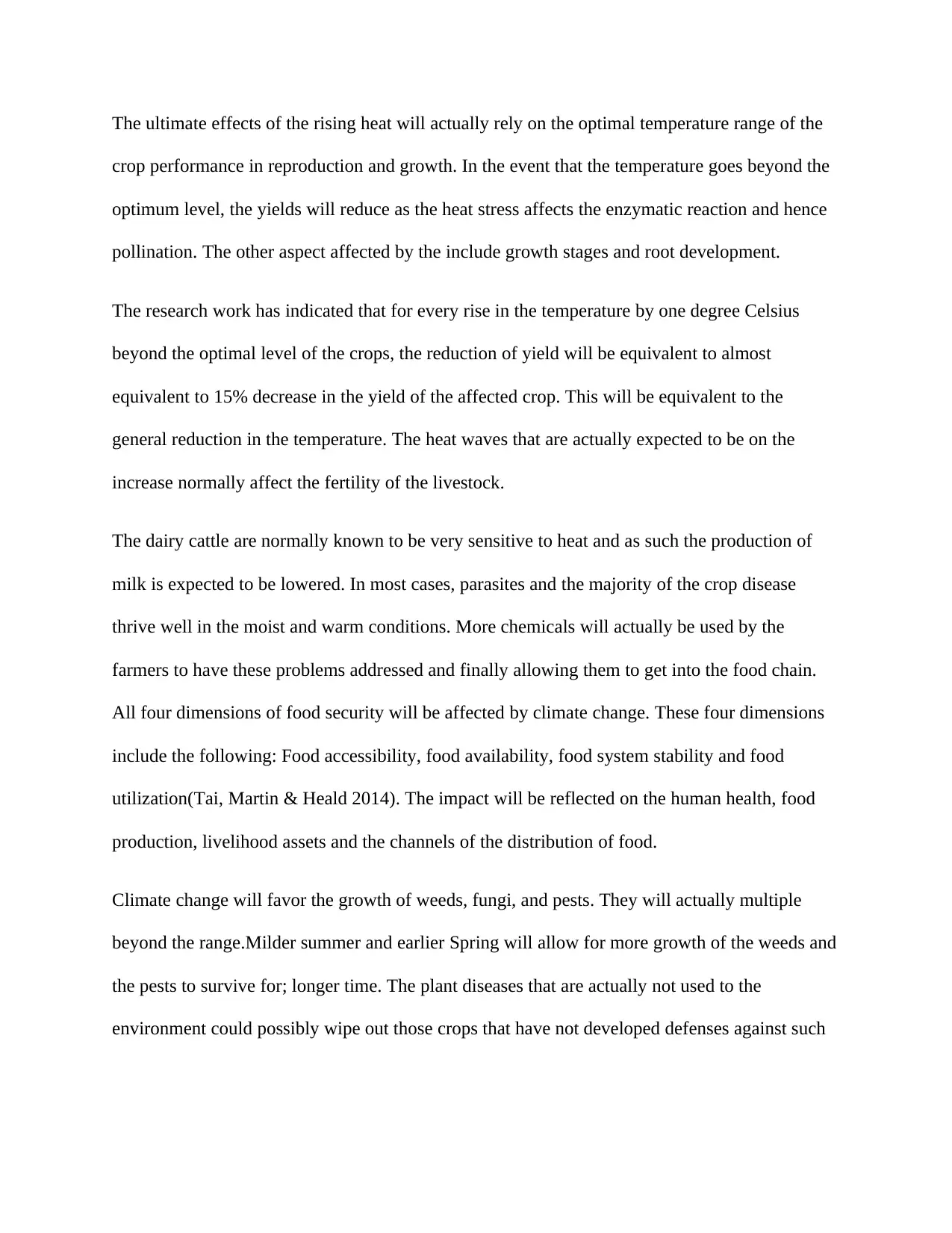
The ultimate effects of the rising heat will actually rely on the optimal temperature range of the
crop performance in reproduction and growth. In the event that the temperature goes beyond the
optimum level, the yields will reduce as the heat stress affects the enzymatic reaction and hence
pollination. The other aspect affected by the include growth stages and root development.
The research work has indicated that for every rise in the temperature by one degree Celsius
beyond the optimal level of the crops, the reduction of yield will be equivalent to almost
equivalent to 15% decrease in the yield of the affected crop. This will be equivalent to the
general reduction in the temperature. The heat waves that are actually expected to be on the
increase normally affect the fertility of the livestock.
The dairy cattle are normally known to be very sensitive to heat and as such the production of
milk is expected to be lowered. In most cases, parasites and the majority of the crop disease
thrive well in the moist and warm conditions. More chemicals will actually be used by the
farmers to have these problems addressed and finally allowing them to get into the food chain.
All four dimensions of food security will be affected by climate change. These four dimensions
include the following: Food accessibility, food availability, food system stability and food
utilization(Tai, Martin & Heald 2014). The impact will be reflected on the human health, food
production, livelihood assets and the channels of the distribution of food.
Climate change will favor the growth of weeds, fungi, and pests. They will actually multiple
beyond the range.Milder summer and earlier Spring will allow for more growth of the weeds and
the pests to survive for; longer time. The plant diseases that are actually not used to the
environment could possibly wipe out those crops that have not developed defenses against such
crop performance in reproduction and growth. In the event that the temperature goes beyond the
optimum level, the yields will reduce as the heat stress affects the enzymatic reaction and hence
pollination. The other aspect affected by the include growth stages and root development.
The research work has indicated that for every rise in the temperature by one degree Celsius
beyond the optimal level of the crops, the reduction of yield will be equivalent to almost
equivalent to 15% decrease in the yield of the affected crop. This will be equivalent to the
general reduction in the temperature. The heat waves that are actually expected to be on the
increase normally affect the fertility of the livestock.
The dairy cattle are normally known to be very sensitive to heat and as such the production of
milk is expected to be lowered. In most cases, parasites and the majority of the crop disease
thrive well in the moist and warm conditions. More chemicals will actually be used by the
farmers to have these problems addressed and finally allowing them to get into the food chain.
All four dimensions of food security will be affected by climate change. These four dimensions
include the following: Food accessibility, food availability, food system stability and food
utilization(Tai, Martin & Heald 2014). The impact will be reflected on the human health, food
production, livelihood assets and the channels of the distribution of food.
Climate change will favor the growth of weeds, fungi, and pests. They will actually multiple
beyond the range.Milder summer and earlier Spring will allow for more growth of the weeds and
the pests to survive for; longer time. The plant diseases that are actually not used to the
environment could possibly wipe out those crops that have not developed defenses against such
Paraphrase This Document
Need a fresh take? Get an instant paraphrase of this document with our AI Paraphraser
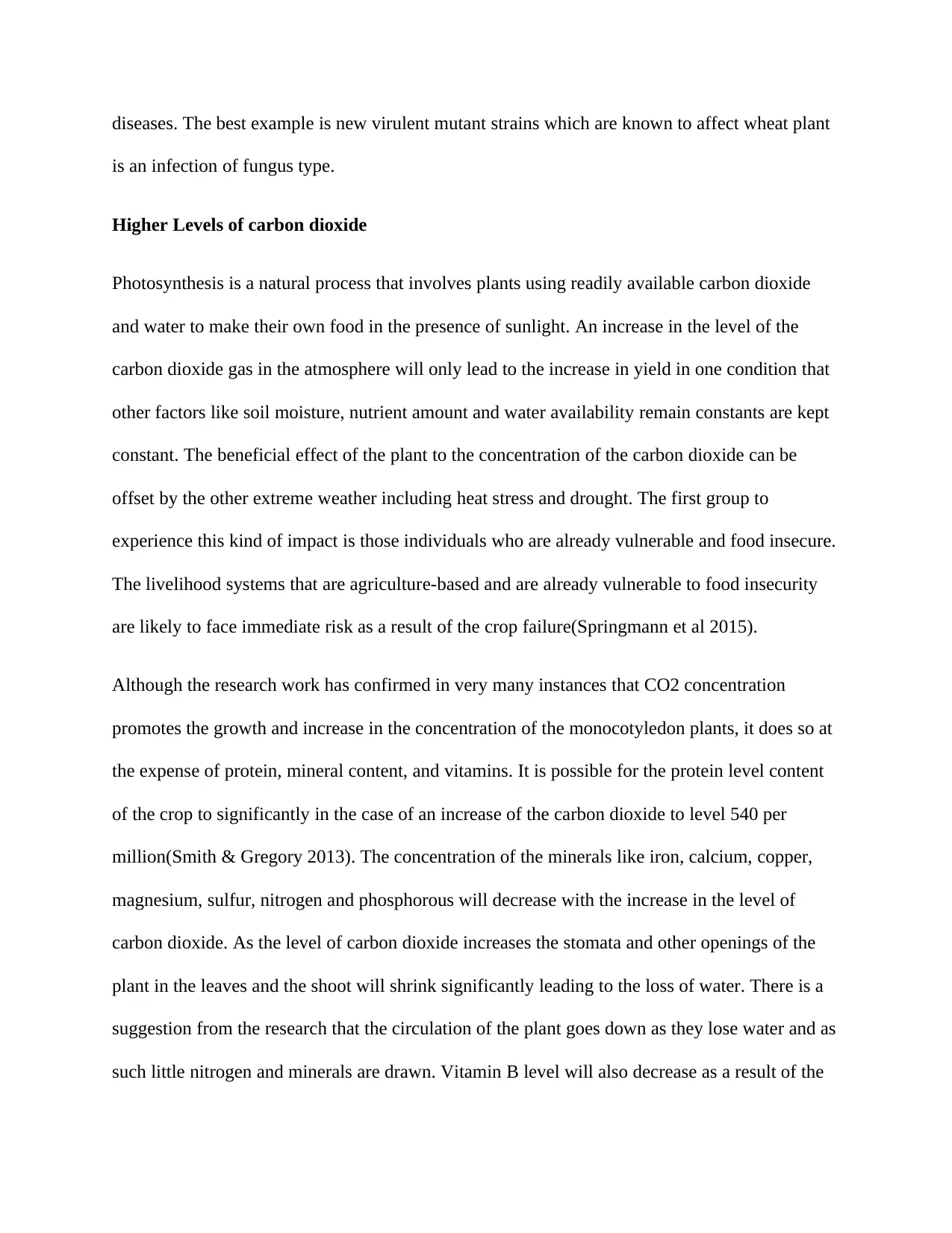
diseases. The best example is new virulent mutant strains which are known to affect wheat plant
is an infection of fungus type.
Higher Levels of carbon dioxide
Photosynthesis is a natural process that involves plants using readily available carbon dioxide
and water to make their own food in the presence of sunlight. An increase in the level of the
carbon dioxide gas in the atmosphere will only lead to the increase in yield in one condition that
other factors like soil moisture, nutrient amount and water availability remain constants are kept
constant. The beneficial effect of the plant to the concentration of the carbon dioxide can be
offset by the other extreme weather including heat stress and drought. The first group to
experience this kind of impact is those individuals who are already vulnerable and food insecure.
The livelihood systems that are agriculture-based and are already vulnerable to food insecurity
are likely to face immediate risk as a result of the crop failure(Springmann et al 2015).
Although the research work has confirmed in very many instances that CO2 concentration
promotes the growth and increase in the concentration of the monocotyledon plants, it does so at
the expense of protein, mineral content, and vitamins. It is possible for the protein level content
of the crop to significantly in the case of an increase of the carbon dioxide to level 540 per
million(Smith & Gregory 2013). The concentration of the minerals like iron, calcium, copper,
magnesium, sulfur, nitrogen and phosphorous will decrease with the increase in the level of
carbon dioxide. As the level of carbon dioxide increases the stomata and other openings of the
plant in the leaves and the shoot will shrink significantly leading to the loss of water. There is a
suggestion from the research that the circulation of the plant goes down as they lose water and as
such little nitrogen and minerals are drawn. Vitamin B level will also decrease as a result of the
is an infection of fungus type.
Higher Levels of carbon dioxide
Photosynthesis is a natural process that involves plants using readily available carbon dioxide
and water to make their own food in the presence of sunlight. An increase in the level of the
carbon dioxide gas in the atmosphere will only lead to the increase in yield in one condition that
other factors like soil moisture, nutrient amount and water availability remain constants are kept
constant. The beneficial effect of the plant to the concentration of the carbon dioxide can be
offset by the other extreme weather including heat stress and drought. The first group to
experience this kind of impact is those individuals who are already vulnerable and food insecure.
The livelihood systems that are agriculture-based and are already vulnerable to food insecurity
are likely to face immediate risk as a result of the crop failure(Springmann et al 2015).
Although the research work has confirmed in very many instances that CO2 concentration
promotes the growth and increase in the concentration of the monocotyledon plants, it does so at
the expense of protein, mineral content, and vitamins. It is possible for the protein level content
of the crop to significantly in the case of an increase of the carbon dioxide to level 540 per
million(Smith & Gregory 2013). The concentration of the minerals like iron, calcium, copper,
magnesium, sulfur, nitrogen and phosphorous will decrease with the increase in the level of
carbon dioxide. As the level of carbon dioxide increases the stomata and other openings of the
plant in the leaves and the shoot will shrink significantly leading to the loss of water. There is a
suggestion from the research that the circulation of the plant goes down as they lose water and as
such little nitrogen and minerals are drawn. Vitamin B level will also decrease as a result of the
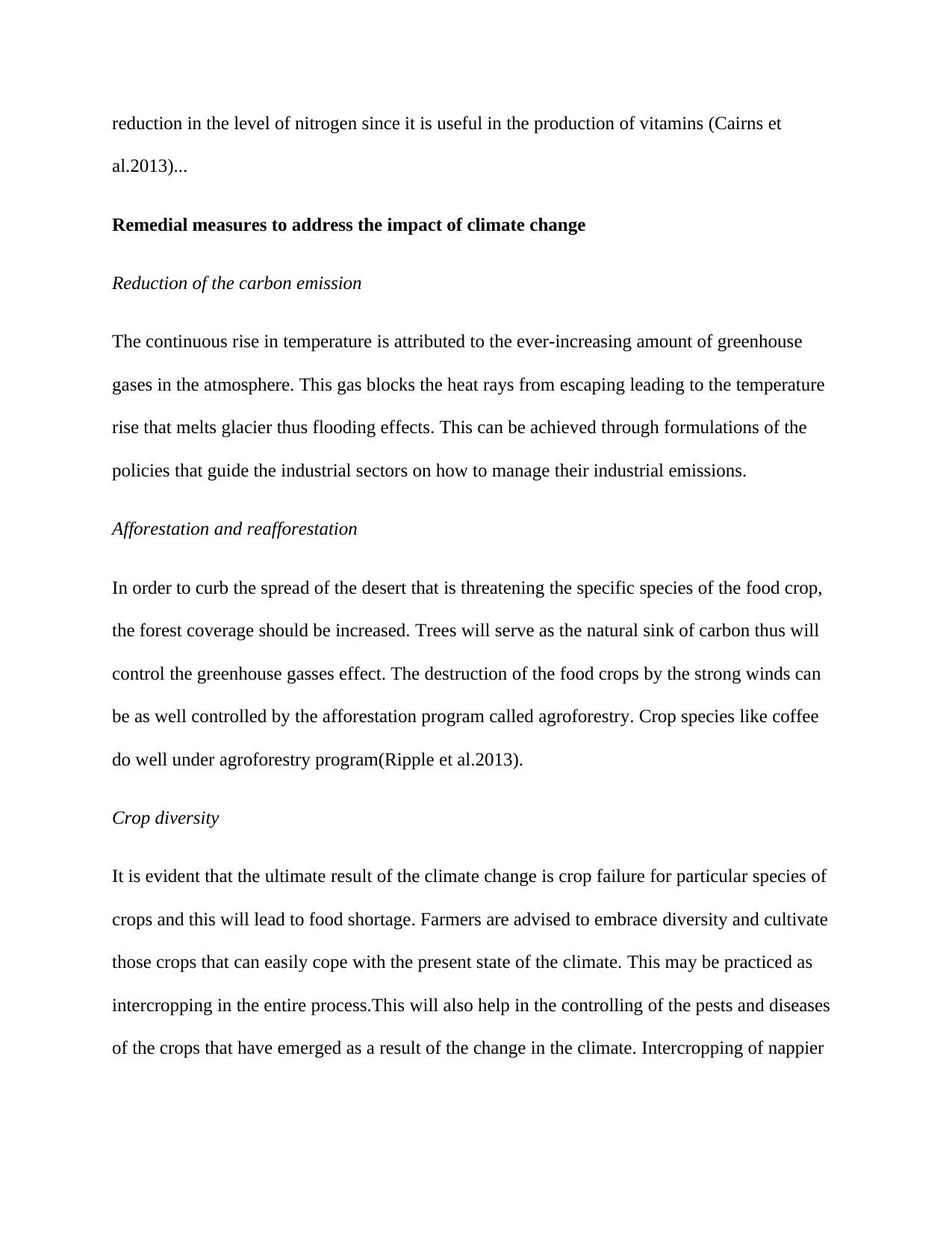
reduction in the level of nitrogen since it is useful in the production of vitamins (Cairns et
al.2013)...
Remedial measures to address the impact of climate change
Reduction of the carbon emission
The continuous rise in temperature is attributed to the ever-increasing amount of greenhouse
gases in the atmosphere. This gas blocks the heat rays from escaping leading to the temperature
rise that melts glacier thus flooding effects. This can be achieved through formulations of the
policies that guide the industrial sectors on how to manage their industrial emissions.
Afforestation and reafforestation
In order to curb the spread of the desert that is threatening the specific species of the food crop,
the forest coverage should be increased. Trees will serve as the natural sink of carbon thus will
control the greenhouse gasses effect. The destruction of the food crops by the strong winds can
be as well controlled by the afforestation program called agroforestry. Crop species like coffee
do well under agroforestry program(Ripple et al.2013).
Crop diversity
It is evident that the ultimate result of the climate change is crop failure for particular species of
crops and this will lead to food shortage. Farmers are advised to embrace diversity and cultivate
those crops that can easily cope with the present state of the climate. This may be practiced as
intercropping in the entire process.This will also help in the controlling of the pests and diseases
of the crops that have emerged as a result of the change in the climate. Intercropping of nappier
al.2013)...
Remedial measures to address the impact of climate change
Reduction of the carbon emission
The continuous rise in temperature is attributed to the ever-increasing amount of greenhouse
gases in the atmosphere. This gas blocks the heat rays from escaping leading to the temperature
rise that melts glacier thus flooding effects. This can be achieved through formulations of the
policies that guide the industrial sectors on how to manage their industrial emissions.
Afforestation and reafforestation
In order to curb the spread of the desert that is threatening the specific species of the food crop,
the forest coverage should be increased. Trees will serve as the natural sink of carbon thus will
control the greenhouse gasses effect. The destruction of the food crops by the strong winds can
be as well controlled by the afforestation program called agroforestry. Crop species like coffee
do well under agroforestry program(Ripple et al.2013).
Crop diversity
It is evident that the ultimate result of the climate change is crop failure for particular species of
crops and this will lead to food shortage. Farmers are advised to embrace diversity and cultivate
those crops that can easily cope with the present state of the climate. This may be practiced as
intercropping in the entire process.This will also help in the controlling of the pests and diseases
of the crops that have emerged as a result of the change in the climate. Intercropping of nappier
⊘ This is a preview!⊘
Do you want full access?
Subscribe today to unlock all pages.

Trusted by 1+ million students worldwide
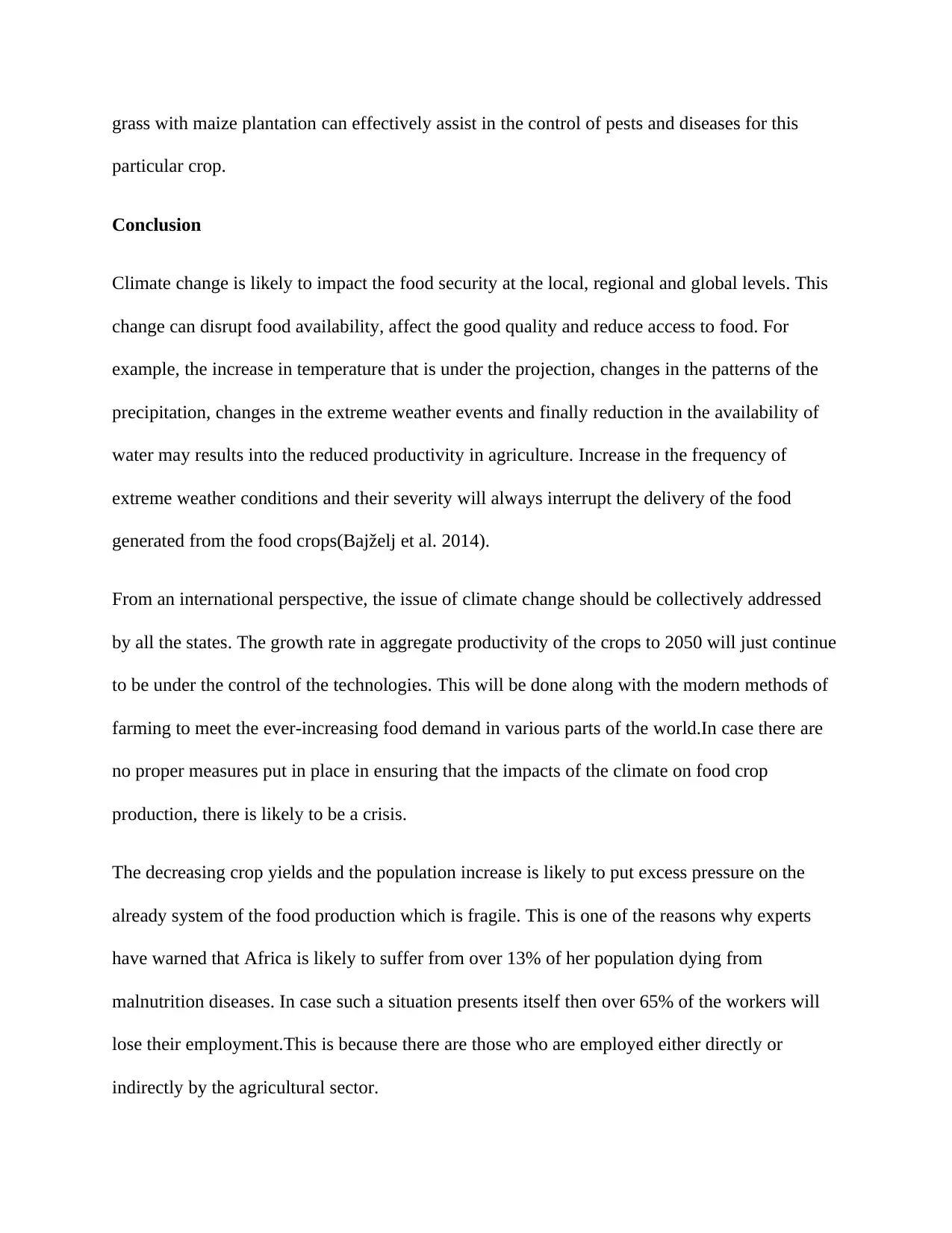
grass with maize plantation can effectively assist in the control of pests and diseases for this
particular crop.
Conclusion
Climate change is likely to impact the food security at the local, regional and global levels. This
change can disrupt food availability, affect the good quality and reduce access to food. For
example, the increase in temperature that is under the projection, changes in the patterns of the
precipitation, changes in the extreme weather events and finally reduction in the availability of
water may results into the reduced productivity in agriculture. Increase in the frequency of
extreme weather conditions and their severity will always interrupt the delivery of the food
generated from the food crops(Bajželj et al. 2014).
From an international perspective, the issue of climate change should be collectively addressed
by all the states. The growth rate in aggregate productivity of the crops to 2050 will just continue
to be under the control of the technologies. This will be done along with the modern methods of
farming to meet the ever-increasing food demand in various parts of the world.In case there are
no proper measures put in place in ensuring that the impacts of the climate on food crop
production, there is likely to be a crisis.
The decreasing crop yields and the population increase is likely to put excess pressure on the
already system of the food production which is fragile. This is one of the reasons why experts
have warned that Africa is likely to suffer from over 13% of her population dying from
malnutrition diseases. In case such a situation presents itself then over 65% of the workers will
lose their employment.This is because there are those who are employed either directly or
indirectly by the agricultural sector.
particular crop.
Conclusion
Climate change is likely to impact the food security at the local, regional and global levels. This
change can disrupt food availability, affect the good quality and reduce access to food. For
example, the increase in temperature that is under the projection, changes in the patterns of the
precipitation, changes in the extreme weather events and finally reduction in the availability of
water may results into the reduced productivity in agriculture. Increase in the frequency of
extreme weather conditions and their severity will always interrupt the delivery of the food
generated from the food crops(Bajželj et al. 2014).
From an international perspective, the issue of climate change should be collectively addressed
by all the states. The growth rate in aggregate productivity of the crops to 2050 will just continue
to be under the control of the technologies. This will be done along with the modern methods of
farming to meet the ever-increasing food demand in various parts of the world.In case there are
no proper measures put in place in ensuring that the impacts of the climate on food crop
production, there is likely to be a crisis.
The decreasing crop yields and the population increase is likely to put excess pressure on the
already system of the food production which is fragile. This is one of the reasons why experts
have warned that Africa is likely to suffer from over 13% of her population dying from
malnutrition diseases. In case such a situation presents itself then over 65% of the workers will
lose their employment.This is because there are those who are employed either directly or
indirectly by the agricultural sector.
Paraphrase This Document
Need a fresh take? Get an instant paraphrase of this document with our AI Paraphraser
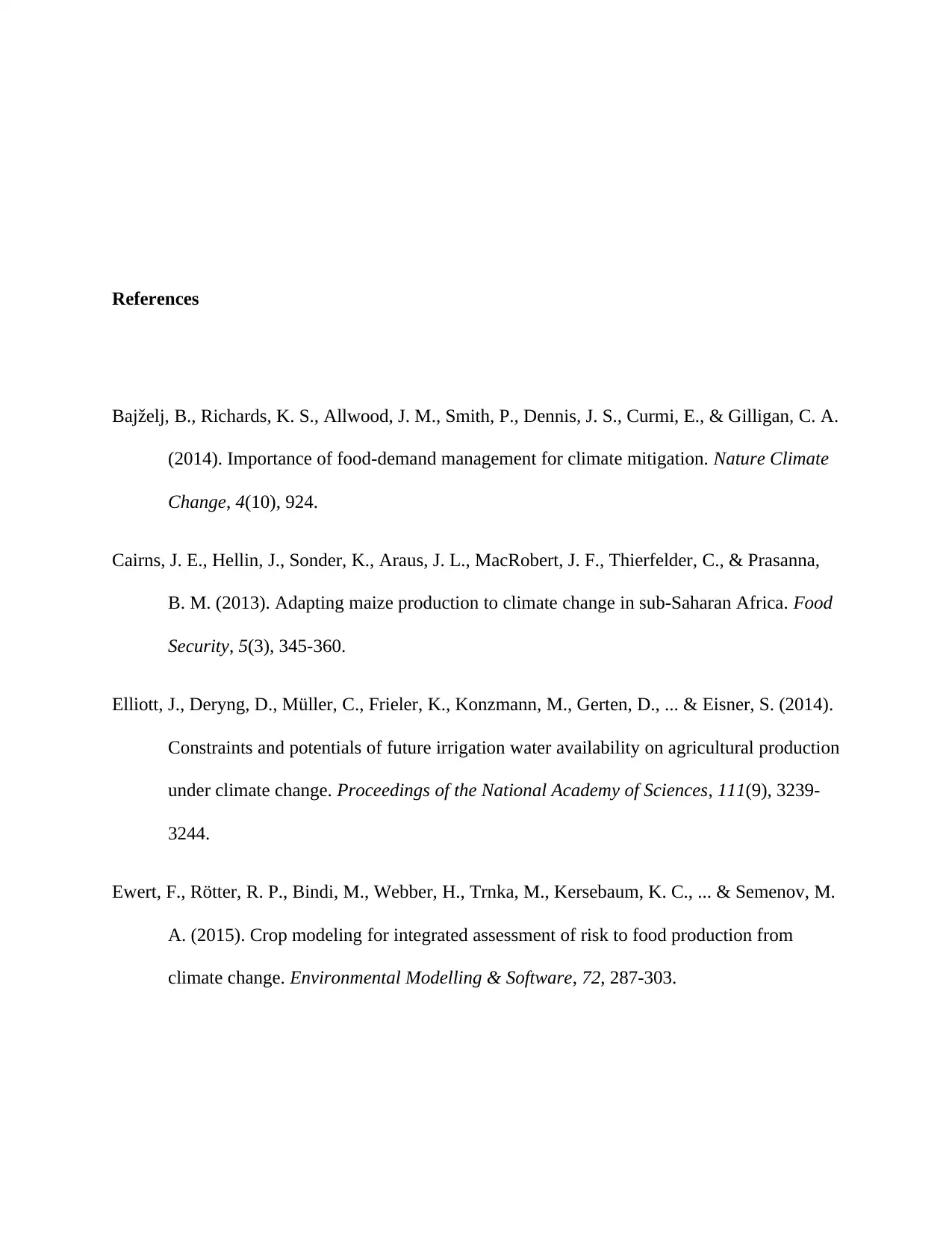
References
Bajželj, B., Richards, K. S., Allwood, J. M., Smith, P., Dennis, J. S., Curmi, E., & Gilligan, C. A.
(2014). Importance of food-demand management for climate mitigation. Nature Climate
Change, 4(10), 924.
Cairns, J. E., Hellin, J., Sonder, K., Araus, J. L., MacRobert, J. F., Thierfelder, C., & Prasanna,
B. M. (2013). Adapting maize production to climate change in sub-Saharan Africa. Food
Security, 5(3), 345-360.
Elliott, J., Deryng, D., Müller, C., Frieler, K., Konzmann, M., Gerten, D., ... & Eisner, S. (2014).
Constraints and potentials of future irrigation water availability on agricultural production
under climate change. Proceedings of the National Academy of Sciences, 111(9), 3239-
3244.
Ewert, F., Rötter, R. P., Bindi, M., Webber, H., Trnka, M., Kersebaum, K. C., ... & Semenov, M.
A. (2015). Crop modeling for integrated assessment of risk to food production from
climate change. Environmental Modelling & Software, 72, 287-303.
Bajželj, B., Richards, K. S., Allwood, J. M., Smith, P., Dennis, J. S., Curmi, E., & Gilligan, C. A.
(2014). Importance of food-demand management for climate mitigation. Nature Climate
Change, 4(10), 924.
Cairns, J. E., Hellin, J., Sonder, K., Araus, J. L., MacRobert, J. F., Thierfelder, C., & Prasanna,
B. M. (2013). Adapting maize production to climate change in sub-Saharan Africa. Food
Security, 5(3), 345-360.
Elliott, J., Deryng, D., Müller, C., Frieler, K., Konzmann, M., Gerten, D., ... & Eisner, S. (2014).
Constraints and potentials of future irrigation water availability on agricultural production
under climate change. Proceedings of the National Academy of Sciences, 111(9), 3239-
3244.
Ewert, F., Rötter, R. P., Bindi, M., Webber, H., Trnka, M., Kersebaum, K. C., ... & Semenov, M.
A. (2015). Crop modeling for integrated assessment of risk to food production from
climate change. Environmental Modelling & Software, 72, 287-303.
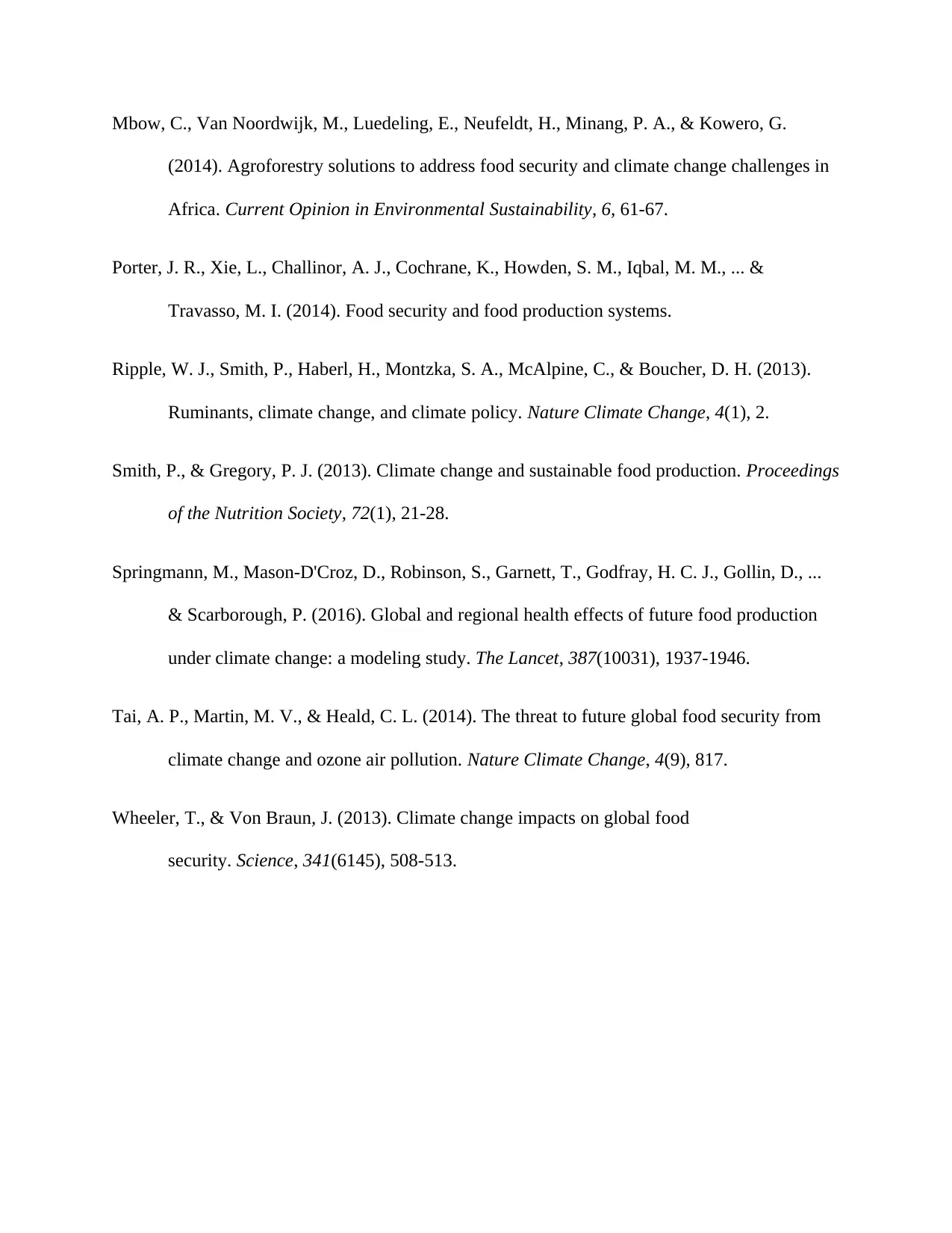
Mbow, C., Van Noordwijk, M., Luedeling, E., Neufeldt, H., Minang, P. A., & Kowero, G.
(2014). Agroforestry solutions to address food security and climate change challenges in
Africa. Current Opinion in Environmental Sustainability, 6, 61-67.
Porter, J. R., Xie, L., Challinor, A. J., Cochrane, K., Howden, S. M., Iqbal, M. M., ... &
Travasso, M. I. (2014). Food security and food production systems.
Ripple, W. J., Smith, P., Haberl, H., Montzka, S. A., McAlpine, C., & Boucher, D. H. (2013).
Ruminants, climate change, and climate policy. Nature Climate Change, 4(1), 2.
Smith, P., & Gregory, P. J. (2013). Climate change and sustainable food production. Proceedings
of the Nutrition Society, 72(1), 21-28.
Springmann, M., Mason-D'Croz, D., Robinson, S., Garnett, T., Godfray, H. C. J., Gollin, D., ...
& Scarborough, P. (2016). Global and regional health effects of future food production
under climate change: a modeling study. The Lancet, 387(10031), 1937-1946.
Tai, A. P., Martin, M. V., & Heald, C. L. (2014). The threat to future global food security from
climate change and ozone air pollution. Nature Climate Change, 4(9), 817.
Wheeler, T., & Von Braun, J. (2013). Climate change impacts on global food
security. Science, 341(6145), 508-513.
(2014). Agroforestry solutions to address food security and climate change challenges in
Africa. Current Opinion in Environmental Sustainability, 6, 61-67.
Porter, J. R., Xie, L., Challinor, A. J., Cochrane, K., Howden, S. M., Iqbal, M. M., ... &
Travasso, M. I. (2014). Food security and food production systems.
Ripple, W. J., Smith, P., Haberl, H., Montzka, S. A., McAlpine, C., & Boucher, D. H. (2013).
Ruminants, climate change, and climate policy. Nature Climate Change, 4(1), 2.
Smith, P., & Gregory, P. J. (2013). Climate change and sustainable food production. Proceedings
of the Nutrition Society, 72(1), 21-28.
Springmann, M., Mason-D'Croz, D., Robinson, S., Garnett, T., Godfray, H. C. J., Gollin, D., ...
& Scarborough, P. (2016). Global and regional health effects of future food production
under climate change: a modeling study. The Lancet, 387(10031), 1937-1946.
Tai, A. P., Martin, M. V., & Heald, C. L. (2014). The threat to future global food security from
climate change and ozone air pollution. Nature Climate Change, 4(9), 817.
Wheeler, T., & Von Braun, J. (2013). Climate change impacts on global food
security. Science, 341(6145), 508-513.
⊘ This is a preview!⊘
Do you want full access?
Subscribe today to unlock all pages.

Trusted by 1+ million students worldwide
1 out of 12
Related Documents
Your All-in-One AI-Powered Toolkit for Academic Success.
+13062052269
info@desklib.com
Available 24*7 on WhatsApp / Email
![[object Object]](/_next/static/media/star-bottom.7253800d.svg)
Unlock your academic potential
Copyright © 2020–2025 A2Z Services. All Rights Reserved. Developed and managed by ZUCOL.





